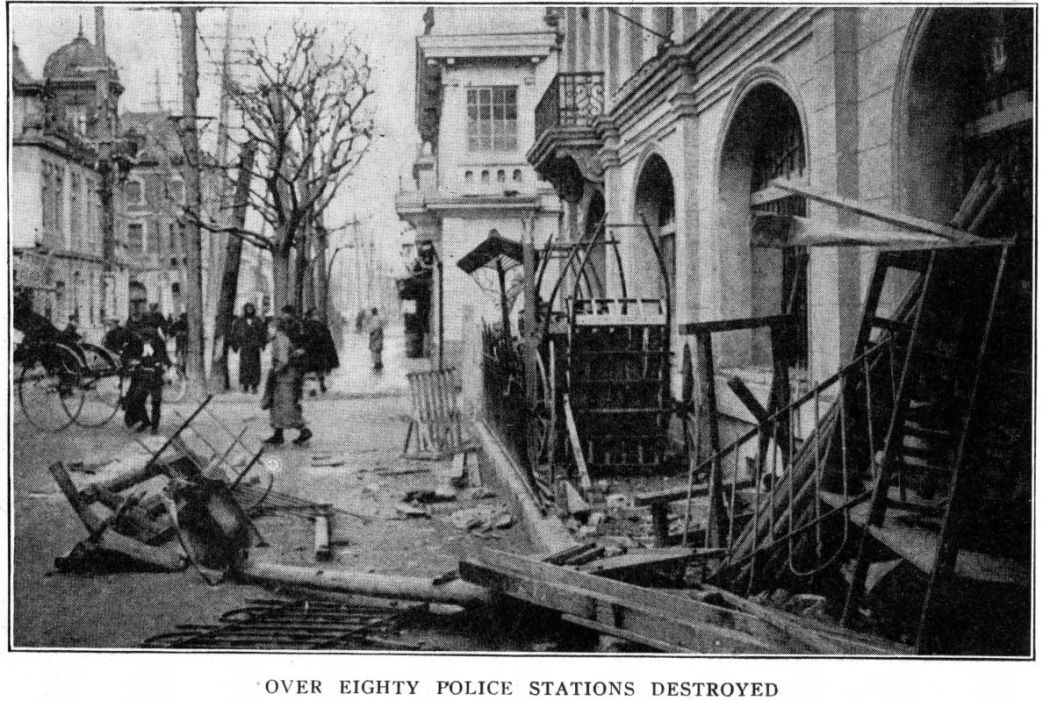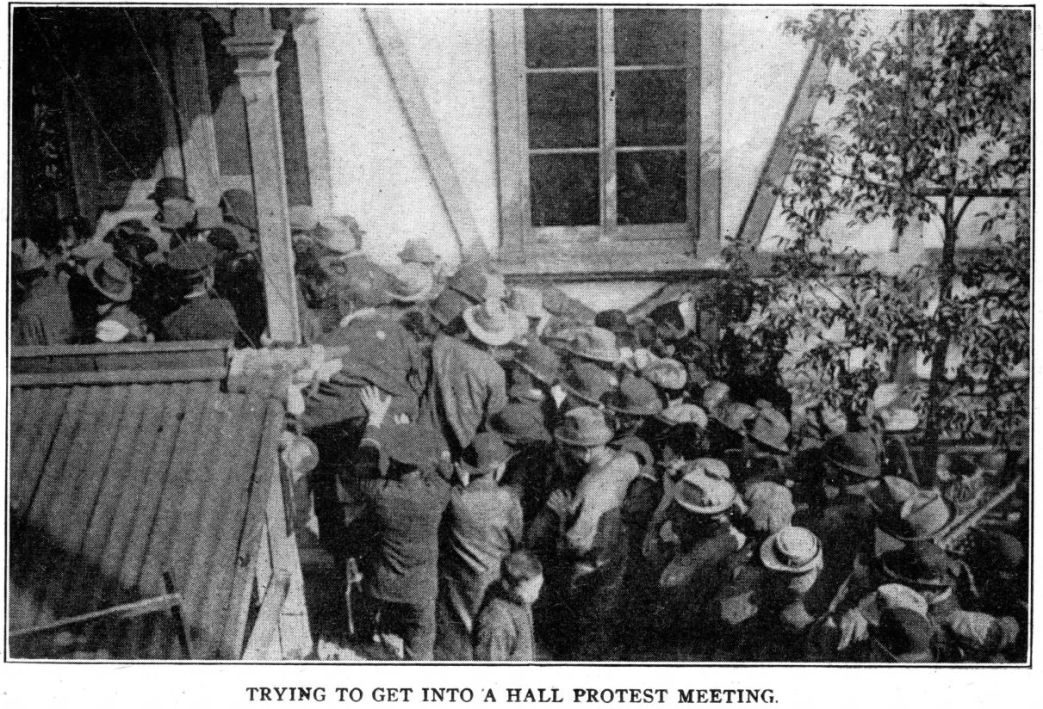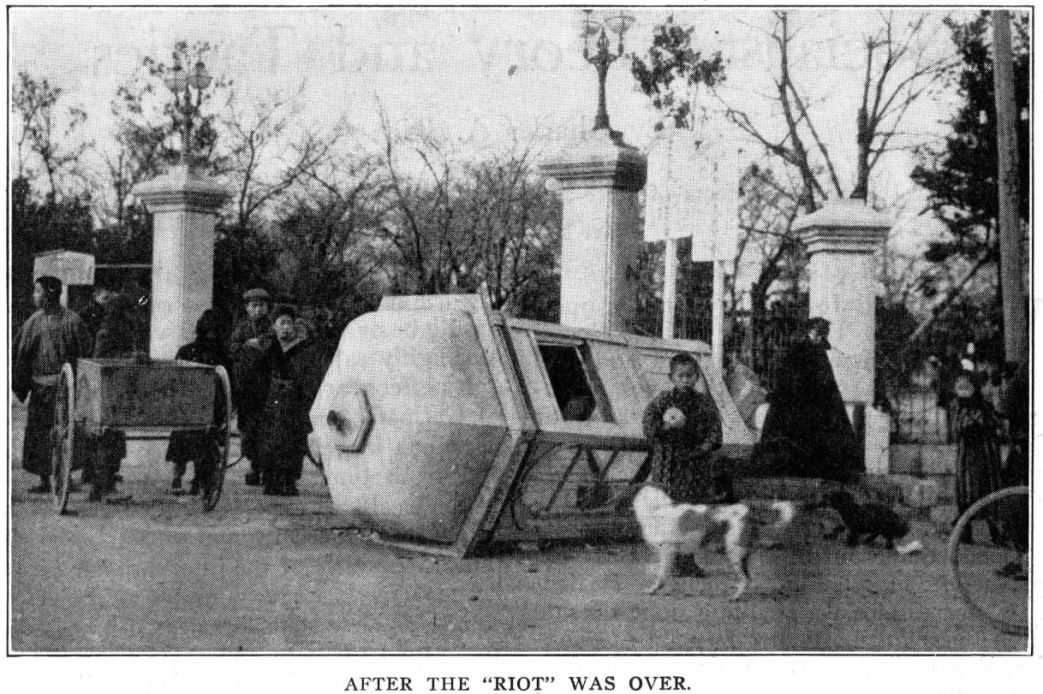A mass democratic movement in Japan forced the resignation of prime minister Katsura Tarō and destroyed over eighty hated police stations. Sen Katayama’s original report included some remarkable photos.
‘The Democratic Uprising in Japan’ by Sen Katayama from the International Socialist Review. 13 No. 10. April, 1913.
THE rapid changes that have been wrought during the last two months in Japan are wonderful even to those who have been a part of them. It was only last December when the new Ministry under Prince Katsura, the sole leader of the bureaucracy, was formed. His able lieutenants have all been faithful servants for the last few decades. Some of the ministers and the inspector-general of the police department of the metropolis are notorious for shooting down the citizens of Tokyo at the time of the great riot at the conclusion of the Russo-Japan war. But the people were not satisfied with the Katsura Ministry at all, and a popular agitation was started by a handful of Socialists who are editing a magazine (three times a month) called “Tokyo Shinbum,” a journal of democratic tone. It is edited to gain some civil liberties, for a Socialist paper is not allowed to exist.
On the 5th of December a mass meeting of the people at the Tokyo Y.M.C.A. hall was called. It was, of course, purely a political meeting to arouse the public sentiment to understand the Katsura regimé. This meeting was at once changed to a monster demonstration against the existing ministry. Several thousand people were present and speakers sounded a keynote of “Batsu-JokuTaiji” (Destroy the bureaucratic class rule!). This meeting was a first cannon sounding the doom of our bureaucracy. Soon political parties took up this battle cry and held two big demonstration meetings at two large theaters in the city successively, which became more and more a big battle cry against the clan government. This move on the part of the political parties was taken up because they had sounded and found out at the first meeting gotten up by our comrades that the people were ripe for the popular movement and the movement against the bureaucracy. This popular movement was taken and carried on not only by the political parties, but also by various bodies. Even students of Imperial University and other colleges in the city took up the cry against the Katsura Ministry. This incessant agitation and demonstrations led the political parties—Seiyukai and Kokumiuto—to act in concert to vote against the Katsura Ministry, first in the form of an interpellation and then in the form of an impeachment. This determined attitude from the opposition caused the Katsura Ministry to suspend the sitting of the Diet for 15 days, from the 21st of January to the 4th of February. At the same time Prince Katsura declared his intention of forming a political party. This declaration was made on the 20th of January. After the suspension of the Diet, the Prince worked very hard to get a sufficient number of M. P.’s to defeat the impeachment against him, but in vain.
He could get only 94 even by money and influence. It needed 191 members to defeat the impeaching resolution.
On the 5th of February the Diet was opened, and the oppositions numbered 246, the Katsura party 94. The oppositions introduced the said resolution and were about to defeat the ministry by voting on it. At the very moment when the vote of confidence was to be taken, the Prince ordered the suspension of the sitting of the Diet for another “five days.”
On this day several thousand people went before the Parliament building and gave a lively demonstration to encourage the oppositions. This was a powerful demonstration, never before made by the people, to stimulate and stir the members of the opposition to fight against the Katsura Ministry.
The government, seeing this great popular demonstration just at the west side and the front of the Parliament building, feared the possible development of a big, powerful democratic movement, and on the 10th of February, when the Diet reopened, the government prepared fully to put down any sign of popular demonstration near and around the Parliament building by calling out 2,340 policemen, 50 mounted gendarmes and 20 mounted policemen. In spite of this high-handed manner of oppression and intimidation, the people gathered together near the Parliament building and crowds came nearer and nearer, and many entered the Diet to hear the debate on the resolution. These crowds near the Diet began to conflict with the police forces, and then the mounted police and gendarmes rode through the crowds right and left, trampling down the people under horses’ hoofs and injuring many. Soon policemen began to fight with the drawn sabers and wounded many innocent and utterly unarmed citizens.

Seeing peaceful and innocent people sabered at random by the police, the crowds soon changed into a veritable mob, but they were not armed, and the only weapons they could command were pebbles and sand. But the supply was inadequate, for the streets were more or less paved.
The armed police, with the aid of mounted gendarmes, drove the crowds away from the vicinity of the Parliament. Now the crowd marched along the streets and stopped in front of bureaucratic dailies and shouted at the prostituted papers. Windows were broken but the majority were peaceful citizens, and many passersby. At last the large crowd came to the front of the Kokumin Shimbun, a noted bureaucratic paper. It shouted its contempt. Suddenly several shots came from windows of the building, and one Hara Gensaku, who had been passing, was shot dead. Several others were hurt. This outrageous attitude of the daily that is protected and aided by the police force, and later by fifty soldiers, enraged the people, who destroyed windows. Again the editor of the daily shot into the crowd.
At such inhuman conduct under the very eyes of the police the people rose in a frenzy and some started to destroy the police stations. One district police headquarters at Shitoya was burned by the enraged mob. It was reported that the policemen fought with sabers and hurt the innocent people by hundreds. Detectives instigated the people to riot, and the regular policemen arrested those pushed into the crowds and carried them away to the police station. Thus the riot of the 10th of February was a police made one.
There were over 80 police stations destroyed; 253 persons were arrested on the 10th. and now they number over 300.
These arrested persons are mostly innocent and peaceful citizens or students who happened to be at the scene or among the crowd. Some were arrested cn the way home from bath houses or on the way home from their business. Wild policemen caused the riot, and now they are arresting some more and will go further. Courts are busily engaged in making criminals.
The democratic movement was taken up by Osaka and other cities and towns. At Osaka some 100 persons were arrested as the result of the fight with the policemen.
The opposition parties are demanding а party government, but it is doubtful whether they can succeed. Within a few days it will be decided. Anyway, stubborn Prince Katsura has given up his clutches on the Ministry at last. A good sign for a popular victory!
The International Socialist Review (ISR) was published monthly in Chicago from 1900 until 1918 by Charles H. Kerr and critically loyal to the Socialist Party of America. It is one of the essential publications in U.S. left history. During the editorship of A.M. Simons it was largely theoretical and moderate. In 1908, Charles H. Kerr took over as editor with strong influence from Mary E Marcy. The magazine became the foremost proponent of the SP’s left wing growing to tens of thousands of subscribers. It remained revolutionary in outlook and anti-militarist during World War One. It liberally used photographs and images, with news, theory, arts and organizing in its pages. It articles, reports and essays are an invaluable record of the U.S. class struggle and the development of Marxism in the decades before the Soviet experience. It was closed down in government repression in 1918.
PDF of full issue: https://www.marxists.org/history/usa/pubs/isr/v13n10-apr-1913-ISR-riaz-ocr.pdf


